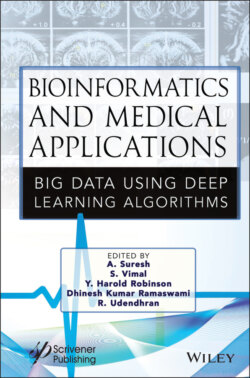Читать книгу Bioinformatics and Medical Applications - Группа авторов - Страница 13
1.1 Introduction
ОглавлениеHealthcare and biomedicine are increasingly using big data technologies for research and development. Mammoth amount of clinical data have been generated and collected at an unparalleled scale and speed. Electronic health records (EHR) store large amounts of patient data. The quality of healthcare can be greatly improved by employing big data applications to identify trends and discover knowledge. Details generated in the hospitals fall in the following categories.
• Clinical data: Doctor’s notes, prescription data, medical imaging reports, laboratory, pharmacy, and insurance related data.
• Patient data: EHRs related to patient admission details, diagnosis, and treatment.
• Machine generated/sensor data: Data obtained from monitoring critical symptoms, emergency care data, web-based media posts, news feeds, and medical journal articles.
The pharmaceutical companies, for example, can effectively utilize this data to identify new potential drug candidates and predictive data modeling can substantially decrease the expenses on drug discovery and improve the decision-making process in healthcare. Predictive modeling helps in producing a faster and more targeted research with respect to drugs and medical devices.
AI depends on calculations that can gain from information without depending on rule-based programming while big data is the type of data that can be supplied to analytical systems so that a machine learning model could learn or, in other words, improve the accuracy of its predictions. Machine learning algorithms is classified in three sorts, particularly supervised, unsupervised, and reinforcement learning.
Perhaps, the most famous procedure in information mining is clustering which is the method of identifying similar groups of data. The groups are created in a manner wherein entities in one group are more similar to each other than to those belonging to the other groups. Although it is an unsupervised machine learning technique, such collections can be used as features in supervised AI model.
Coronary illness, the primary reason behind morbidness and fatality globally, was responsible for more deaths annually compared to any other cause [1]. Fortunately, cardiovascular failures are exceptionally preventable and straightforward way of life alterations alongside early treatment incredibly improves the prognosis. It is, nonetheless, hard to recognize high-risk patients because of the presence of different factors that add to the danger of coronary illness like diabetes, hypertension, and elevated cholesterol. This is where information mining and AI have acted the hero by creating screening devices. These devices are helpful on account of their predominance in pattern recognition and classification when contrasted with other conventional statistical methodologies.
For exploring this with the assistance of machine learning algorithms, we gathered a dataset of vascular heart disease from Kaggle [3]. It consists of three categories of input features, namely, objective consisting of real statistics, examination comprising of results of clinical assessment, and subjective handling patient related information.
Based on this information, we applied various machine learning algorithms and analyzed the accuracy achieved by each of the methods. For this report, we have used Naive Bayes, Decision Tree, Random Forest, and various combinations of using these algorithms in order to further improve the accuracy. Numerous scientists have just utilized this dataset for their examination and delivered their individual outcomes. The target of gathering and applying methods on this dataset is to improve the precision of our model. For this reason, we gave different algorithms a shot on this dataset and successfully improved the accuracy of our model.
We suggested using the ensemble method [2] which is the process of solving a particular computer intelligence problem by strategically combining multiple models, such as classifiers or experts. Additionally, we have take the wrongly classified records by all the methods and tried to understand the reason for wrong classification and modify it mathematically in order to give accurate results and improve model performance continuously.
